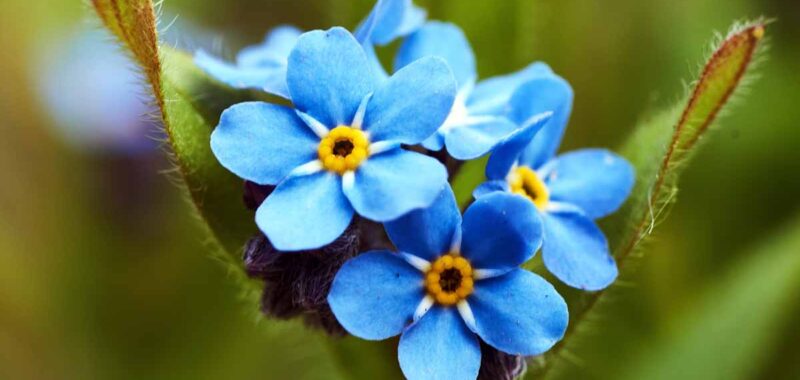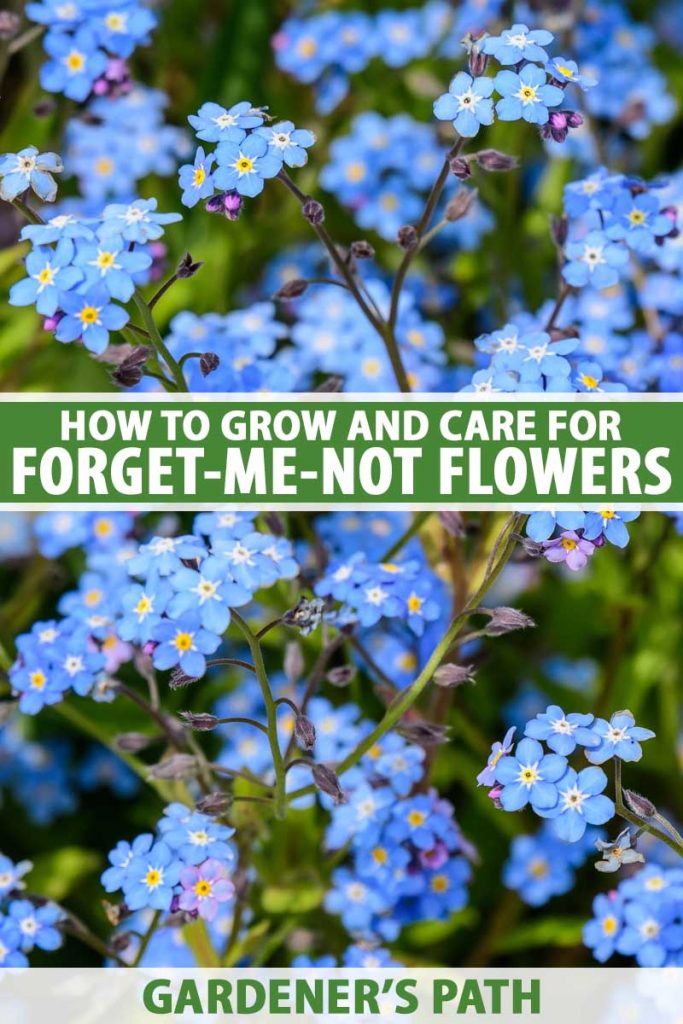Myosotis sylvatica
Like tiny pieces of bright blue sky dropped into your garden, forget-me-nots are one of the few true-blue flowers available to gardeners.
These plants are steeped in history and symbolism, and are easy beauties to grow.


We link to vendors to help you find relevant products. If you buy from one of our links, we may earn a commission.
So go ahead, plan some of your very own!
Just read this article first to learn everything you need to know before you get started.
The genus name Myosotis means “mouse ear,” named after the rounded shape of these plants’ fuzzy leaves.
There are about 100 species in the genus, and the majority of these are known commonly as forget-me-not or scorpion grass.
Found typically in temperate regions, some species occur in alpine areas.
Quick Look
Common name(s): Forget-me-nots, scorpion grass
Plant type: Herbaceous flowering biennial
Hardiness (USDA Zone): 3-8
Native to: Eurasia
Bloom time: Spring to summer
Exposure: Full sun to part shade
Soil type: Sandy, loamy, clay, well draining
Soil pH: 6.0-8.0, slightly acidic to slightly alkaline
Spacing: 4-6 inches
Planting depth: Soil surface (seeds), depth of root ball (transplants)
Mature size: 6-9 inches wide x 6-12 inches high
Water Needs: Medium
Taxonomy
Order: Apiales
Family: Boraginaceae
Genus: Myosotis
Species: Sylvatica
Cultivars: Various
Most species are native to western Eurasia and New Zealand, while only ten species are found growing wild in North America, South America, Africa, New Guinea, and Australia.
Although this plant had already been a favorite of French and German gardeners for centuries, it only became popular in British gardens in the 1800s.
Of the 100 species, there are three that are most commonly grown as garden plants.
Myosotis sylvatica, also called woodland forget-me-not, is a biennial native to Europe and parts of South Asia including Bhutan, India and Nepal.


It’s a short-lived annual but is usually grown as a biennial. Meaning it is planted the first year and flowers in the second year and then dies. However, it readily reseeds itself giving the appearance of a perennial and allowing you to enjoy the flowers year after year.
Woodland forget-me-nots grows in woodlands, forests, and rocky places. This species is the most widely cultivated variety and it is the main focus of this guide, but some other species have similar growing requirements.
Prone to crowding out other native plants, this can become an issue when it escapes cultivation in non-native areas including North America and Australia.


Along with M. scorpioides, known as true or water forget-me-not, it is considered an invasive and noxious weed in some midwestern states.
Another notable species happens to be the state flower of Alaska.
M. asiatica, also known as alpine forget-me-not, is a short lived, summer-blooming biennial native to the northwestern states and provinces of the US and Canada.
It is a beautiful rock garden plant and can be an excellent alternative if the other two species described above are considered invasive in your area.


Forget-me-not flowers carry a lot of meaning, often pertaining to their sentimental name.
According to legend, a drowning knight tossed a bouquet of the blue blooms to his lover standing on the banks, with the cry “forget me not!” and the name was born.
Since then, the flowers have become a symbol of remembrance.
How to Grow
Forget-me-nots are delightfully charming plants that thrive with minimal fuss, provided you give them the right growing conditions. These dainty blooms might look delicate, but they’re surprisingly resilient
Here’s how to grow them successfully:
Light
Forget-me-nots prefer partial shade to full sun, but the best flowering typically occurs in locations with filtered light or morning sun followed by afternoon shade.
In cooler climates, they can handle more direct sun, but in hot regions, make sure to give them some shelter from the intense afternoon rays to prevent wilting or leaf scorch.
Soil
Woodland forget-me-not does well in a variety of soils, including sandy, loamy, or clay types.
Provided it is a well draining spot and you keep the soil moist, it can tolerate a wide pH range, from mildly acidic to mildly alkaline (6.0-8.0).
If your soil is heavy clay or overly sandy, amend it with compost to improve texture and nutrient content.
Temperature and Humidity
Forget-me-nots are hardy in USDA Zones 3 to 8, depending on the species. They prefer cooler weather and may struggle in prolonged heat.


These plants do particularly well in areas with high humidity and moist soil conditions, especially in the spring and early summer when they naturally bloom.
If you live in a hot and dry climate, consider planting them in a shadier, moisture-retentive part of your garden.
Water
Consistent moisture is key to keeping forget-me-nots happy. The soil should remain evenly moist, like a well-wrung-out sponge.
Avoid letting the soil dry out completely, especially when the plants are in bloom. At the same time, standing water or soggy conditions can lead to root rot.
A layer of mulch around the base of the plants can help retain soil moisture and regulate temperature.
These flowers can tolerate drought but will go dormant in the hottest part of the summer once seed has been set.
Fertilizer
Forget-me-nots generally don’t require heavy feeding. If your soil is rich in organic matter, they’ll get most of what they need from there.
If you have less than ideal soil conditions, fertilize your plant once a month in the spring and summer, especially if the leaves are yellowing.
Use a fertilizer with a 5-10-10 NPK ratio or similar, and apply according to package directions.
Container Growing
Forget-me-nots make lovely container plants, particularly as a trailing or border option in mixed arrangements.


Use well draining soil in a container with good drainage, and keep an even closer eye on soil moisture when potted versus when planted in the ground as containers dry out quickly!
Fertilize as you would in the ground and allow the plants to have some shade during the day.
Cultivars to Select
Think forget-me-not and, if you’re like me, you probably think of brilliant blue flowers.
You’re right, the blooms of M. sylvatica are typically varying shades of bright, true blue. However, there are some pink and white cultivars available as well!
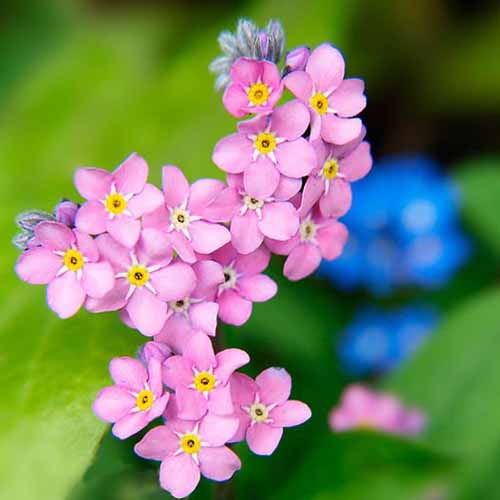

Rose Forget-Me-Not
Eden Brothers Nursery offers packets of rose, indigo, white, or dwarf ultramarine M. sylvatica seeds that will make a lovely addition to the garden.
Or, if you can’t decide which color to choose, try pink, blue, and white all together in a mixed collection that’s available in a small packet or in bulk at Eden Brothers.
Bluesylva
Part of the Sylva series, ‘Bluesylva’ has bright blue flowers with a yellow eye and is a low spreading biennial cultivar with spring and early summer beauty.
Snowsylva
Blooming with loads of bright white, yellow-eyed flowers in early spring to late summer, this garden favorite is also a part of the popular Sylva series.
Victoria Blue
Just in case you need another classic, sky-mirroring forget-me-not cultivar, ‘Victoria Blue’ features petite, dazzling flowers on a compact plant.
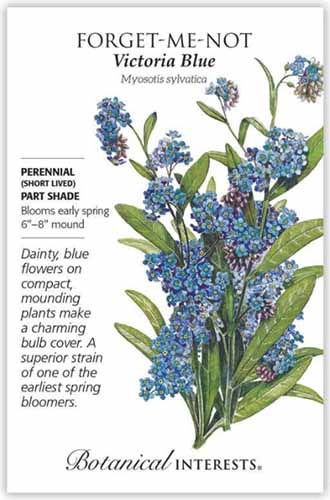

‘Victoria Blue’
‘Victoria Blue’ is available in 250-milligram seed packets at Botanical Interests.
Victoria Pink
Compact and sporting lots of small pink flowers with white centers, ‘Victoria Pink’ is an early spring bloomer.
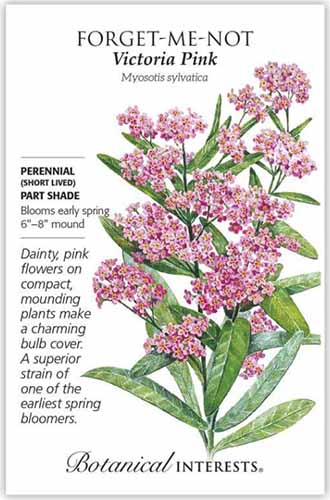

‘Victoria Pink’
Seeds in 250-milligram packets are available from Botanical Interests.
Maintenance
Though these plants require no pruning in the usual sense, a little annual garden maintenance is required if you want to curb their spread.


To keep forget-me-nots from self-seeding in places where you might not want them to sprout next year, be sure to deadhead before the blooms go to seed.
Volunteers may be transplanted to other places in the garden as well.
Older plants that survive beyond the second year as perennials can be divided to keep them healthy, ensuring that they have plenty of room to spread.
Propagation
Myositis plants are relatively easy to propagate, whether via seed or by division.
Most garden forget-me-nots will be biennial, growing from seeds dispersed in late summer and fall, flowering and dispersing seed the following year, and dying afterwards.
But because they self-seed readily, it’s easy to keep your flower patch going.
From Seed
M. sylvatica sets seed in the heat of the summer and will self seed readily, which means they will persist for years in your garden if you don’t deadhead after they bloom. The seeds are dispersed further by animals and water.
You can collect seeds from your plants before they are spread naturally, or purchase seeds at your local nursery or online.
Direct sow the seeds in your garden in midsummer. To prepare the soil, rake to loosen it and smooth out the surface, then water lightly.


Broadcast the seeds on the surface of the soil, or sow individually four inches apart. Seedlings will appear in the fall and plants will bloom the following spring.
Alternatively, you may start seeds indoors eight to ten weeks before the last frost in small pots filled with moistened soilless medium.
Here’s how:
- Sow three to four seeds together and lightly push them into the surface of the medium.
- Keep the pots in a dark, warm location around 64-68°F, and make sure the medium stays moist. The seeds will germinate within 14 to 21 days.
- Rather than watering from above, set the pots in a dish of water to water them from below to prevent root rot.
- Start hardening off when the seedlings have two sets of true leaves. You can choose to transplant immediately after hardening off, or wait until fall to transplant.
Plants transplanted in the spring should bloom that same year, and those planted in the fall will produce flowers the following spring.
By Division
Although most plants will only live as biennials, some may survive a bit longer as short-lived perennials, depending on the variety and growing conditions.
Divide surviving forget-me-nots every three to five years in the spring after flowering, or in the early fall. Carefully dig up the root ball and divide it by pulling the roots apart by hand.
Replant the divisions as outlined below.
Transplanting
If you bought potted plants from a nursery, set them out in the spring or fall as you would with your own plants grown from seed.
Make sure you choose a spot that is well draining and moist. Water potted plants well before transplanting.
Dig a hole slightly larger than the size of the root ball or pot, loosen the soil in the bottom of the hole, insert the root ball, and backfill. Make sure the soil isn’t piled too high or touching the base of the stem.
Water in after planting.
Pests and Disease
There aren’t very many pests that affect forget-me-not, but there are several diseases to keep an eye out for and try to prevent.
Powdery Mildew
Powdery mildew often appears when air circulation is poor or humidity is high. It starts as a white, powdery coating on the leaves and can spread quickly if not addressed.
Removing affected foliage and using fungicidal sprays as needed can keep it in check.
Rust
Rust may also show up, particularly in moist environments. It appears as small orange, yellow, or brown pustules on the undersides of leaves.
Infected leaves should be pruned and destroyed, and watering should be done at the soil level to avoid splashing spores onto healthy foliage.
Crown Rot
Crown rot is a more serious concern, particularly in overly wet soil. Caused by soilborne fungi, this disease results in mushy, discolored crowns and a general collapse of the plant
Once symptoms appear, there’s little that can be done. Prevention is key—ensure well-draining soil and avoid watering directly at the base of the plants.
Staying ahead of these issues with regular inspections and prompt action can help your forget-me-nots thrive all season long.
Best Uses
Imagine a border of blue encircling or underplanting a bed of tulips, roses, or shrubs, or an entire bed of forget-me-nots dazzling the bees, butterflies, and humans that visit.
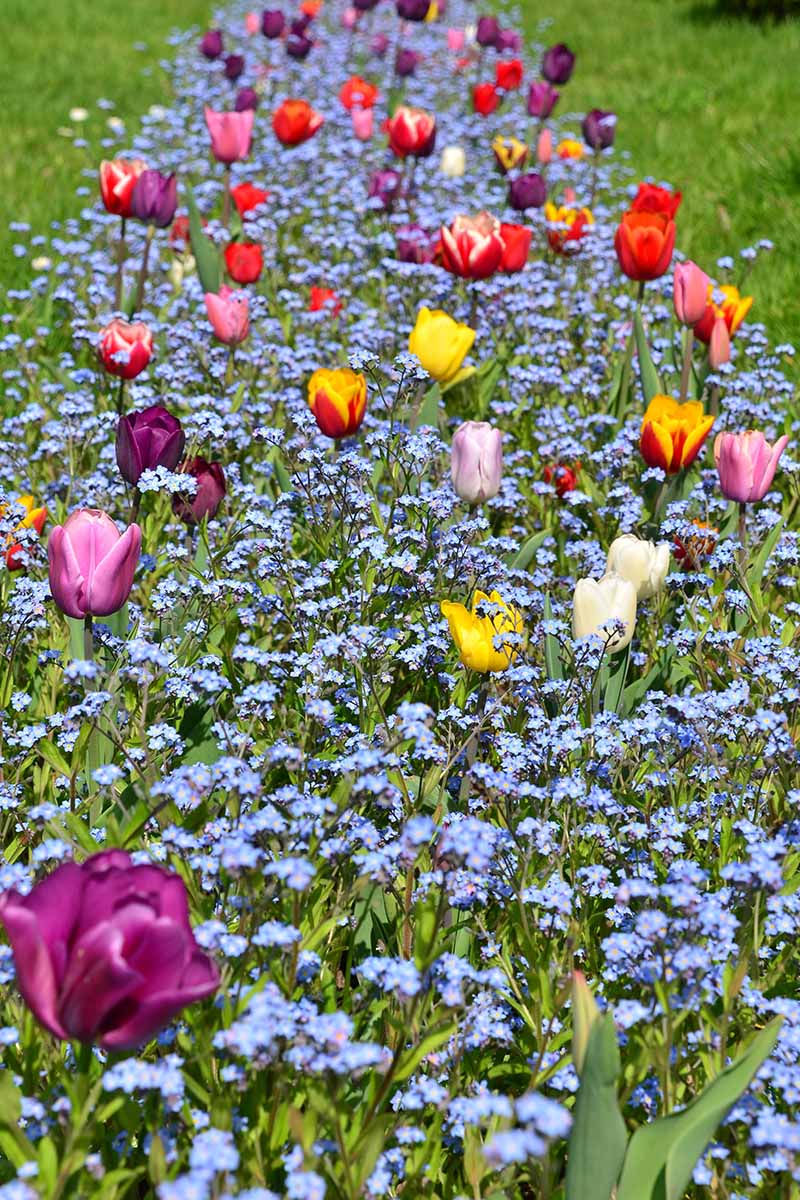

Forget-me-nots look fabulous and do well planted on slopes and banks as a ground cover, and they are just as happy in the garden as they are growing in a container on the patio
Unforgettable
This sky blue flowering plant has been a cherished garden favorite for centuries, with good reason.
Easy to grow, and able to reseed itself year after year, the unusual bright blue flowers are an eye-catching delight.


Cultivars in pink, white, and other shades are beautiful as well. And, thanks to the ill-fated knight who gave this plant its unforgettable name (allegedly!), the forget-me-not remains a symbol of remembrance worldwide.
Do you live somewhere that features these flowers as a symbol for a special day or occasion? We’d love to hear about your experience with this plant, so tell us in the comments below!
Love forget-me-nots? There are many beautiful plants in the Boraginaceae family, and many are champions at attracting pollinators. My favorite: borage itself. Honey bees love it!
And to learn more about growing flowers in your garden, check out these guides next:
© Ask the Experts, LLC. ALL RIGHTS RESERVED. See our TOS for more details. Originally published April 25th, 2021. Last updated April 25th, 2025. Product photos via Arbico Organics, Botanical Interests, and Eden Brothers. Uncredited photos: Shutterstock. With additional writing and editing by Allison Sidhu.

